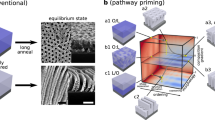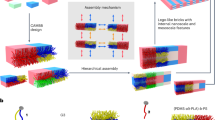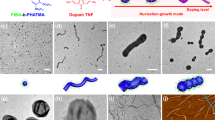Abstract
Block copolymer self-assembly is a powerful tool for two-dimensional nanofabrication; however, the extension of this self-assembly concept to complex three-dimensional network structures is limited. Here we report a simple method to experimentally generate three-dimensional layered mesh morphologies through intrinsic molecular confinement self-assembly. We designed triblock bottlebrush polymers with two Janus domains: one perpendicular and one parallel to the polymer backbone. The former enforces a lamellar superstructure that intrinsically confines the intralayer self-assembly of the latter, giving rise to a mesh-like monoclinic (54°) M15 network substructure with excellent long-range order, as well as a tetragonal (90°) T131 mesh. Numerical simulations show that the spatial constraints exerted on the polymer backbone drive the assembly of M15 and yield T131 in the strong segregation regime. This work demonstrates that intrinsic molecular confinement is a viable path to bottom-up assembly of new geometrical phases of soft matter, extending the capabilities of block copolymer nanofabrication.
This is a preview of subscription content, access via your institution
Access options
Access Nature and 54 other Nature Portfolio journals
Get Nature+, our best-value online-access subscription
$29.99 / 30 days
cancel any time
Subscribe to this journal
Receive 12 print issues and online access
$259.00 per year
only $21.58 per issue
Buy this article
- Purchase on Springer Link
- Instant access to full article PDF
Prices may be subject to local taxes which are calculated during checkout




Similar content being viewed by others
Data availability
The raw data for STEM tomography and 3D reconstruction is provided in Supplementary Video 1. The LAMMPS input and output datasets are too large to be shared publicly but are available from the corresponding authors upon request. All other data needed to evaluate the conclusions of this study are available within the Article and its Supplementary Information.
Code availability
The code generated during this study is available via GitHub at https://github.com/Z-H-Sun/IMCmesh.
References
Bates, F. S. & Fredrickson, G. H. Block copolymers—designer soft materials. Phys. Today 52, 32–38 (1999).
Hamley, I. W. Nanostructure fabrication using block copolymers. Nanotechnology 14, R39–R54 (2003).
Segalman, R. A. Patterning with block copolymer thin films. Mater. Sci. Eng. R Rep. 48, 191–226 (2005).
Bolton, J., Bailey, T. S. & Rzayev, J. Large pore size nanoporous materials from the self-assembly of asymmetric bottlebrush block copolymers. Nano Lett. 11, 998–1001 (2011).
Kawamoto, K. et al. Graft-through synthesis and assembly of Janus bottlebrush polymers from A-branch-B diblock macromonomers. J. Am. Chem. Soc. 138, 11501–11504 (2016).
Cheng, L.-C. et al. Imparting superhydrophobicity with a hierarchical block copolymer coating. Small 16, 1905509 (2020).
Tavakkoli, K. G. et al. Multilayer block copolymer meshes by orthogonal self-assembly. Nat. Commun. 7, 10518 (2016).
Tavakkoli, K. G. et al. Templating three-dimensional self-assembled structures in bilayer block copolymer films. Science 336, 1294–1298 (2012).
Zhang, L. et al. A nanomesh scaffold for supramolecular nanowire optoelectronic devices. Nat. Nanotechnol. 11, 900–906 (2016).
Bai, X. et al. Room-temperature processing of silver submicron fiber mesh for flexible electronics. npj Flex. Electron. 2, 3 (2018).
Kim, S. Y. et al. Large-area nanosquare arrays from shear-aligned block copolymer thin films. Nano Lett. 14, 5698–5705 (2014).
Majewski, P. W., Rahman, A., Black, C. T. & Yager, K. G. Arbitrary lattice symmetries via block copolymer nanomeshes. Nat. Commun. 6, 7448 (2015).
Liu, R., Huang, H., Sun, Z., Alexander-Katz, A. & Ross, C. A. Metallic nanomeshes fabricated by multimechanism directed self-assembly. ACS Nano 15, 16266–16276 (2021).
Cha, S. K. et al. Nanopatterns with a square symmetry from an orthogonal lamellar assembly of block copolymers. ACS Appl. Mater. Interfaces 11, 20265–20271 (2019).
Subramanian, A., Tiwale, N., Doerk, G., Kisslinger, K. & Nam, C.-Y. Enhanced hybridization and nanopatterning via heated liquid-phase infiltration into self-assembled block copolymer thin films. ACS Appl. Mater. Interfaces 12, 1444–1453 (2020).
Jeong, J. W. et al. High-resolution nanotransfer printing applicable to diverse surfaces via interface-targeted adhesion switching. Nat. Commun. 5, 5387 (2014).
Chu, C. Y. et al. Real-space evidence of the equilibrium ordered bicontinuous double diamond structure of a diblock copolymer. Soft Matter 11, 1871–1876 (2015).
Chang, C.-Y. et al. Mesoscale networks and corresponding transitions from self-assembly of block copolymers. Proc. Natl Acad. Sci. USA 118, e2022275118 (2021).
Bailey, T. S., Hardy, C. M., Epps, T. H. & Bates, F. S. A noncubic triply periodic network morphology in poly(isoprene-b-styrene-b-ethylene oxide) triblock copolymers. Macromolecules 35, 7007–7017 (2002).
Takenaka, M. et al. Orthorhombic Fddd network in diblock copolymer melts. Macromolecules 40, 4399–4402 (2007).
Epps, T. H. et al. Ordered network phases in linear poly(isoprene-b-styrene-b-ethylene oxide) triblock copolymers. Macromolecules 37, 8325–8341 (2004).
Tyler, C. A. & Morse, D. C. Orthorhombic Fddd network in triblock and diblock copolymer melts. Phys. Rev. Lett. 94, 208302 (2005).
Meuler, A. J., Hillmyer, M. A. & Bates, F. S. Ordered network mesostructures in block polymer materials. Macromolecules 42, 7221–7250 (2009).
Bluemle, M. J., Fleury, G., Lodge, T. P. & Bates, F. S. The O52 network by molecular design: CECD tetrablock terpolymers. Soft Matter 5, 1587–1590 (2009).
Ding, Y. et al. Emergent symmetries in block copolymer epitaxy. Nat. Commun. 10, 2974 (2019).
Zheng, W. & Wang, Z.-G. Morphology of ABC triblock copolymers. Macromolecules 28, 7215–7223 (1995).
Mogi, Y. et al. Superlattice structures in morphologies of the ABC triblock copolymers. Macromolecules 27, 6755–6760 (1994).
Guo, Z.-H. et al. Janus graft block copolymers: design of a polymer architecture for independently tuned nanostructures and polymer properties. Angew. Chem. Int. Ed. 57, 8493–8497 (2018).
Liang, R. et al. Hierarchically engineered nanostructures from compositionally anisotropic molecular building blocks. Nat. Mater. 21, 1434–1440 (2022).
Chen, Y. Nanofabrication by electron beam lithography and its applications: a review. Microelectron. Eng. 135, 57–72 (2015).
Li, K. et al. High speed e-beam writing for large area photonic nanostructures—a choice of parameters. Sci. Rep. 6, 32945 (2016).
Sinturel, C., Bates, F. S. & Hillmyer, M. A. High χ–low N block polymers: how far can we go? ACS Macro Lett. 4, 1044–1050 (2015).
Jung, Y. S. & Ross, C. A. Orientation-controlled self-assembled nanolithography using a polystyrene−polydimethylsiloxane block copolymer. Nano Lett. 7, 2046–2050 (2007).
Gu, W., Hong, S. W. & Russell, T. P. Orienting block copolymer microdomains with block copolymer brushes. ACS Nano 6, 10250–10257 (2012).
Gotrik, K. W. et al. Morphology control in block copolymer films using mixed solvent vapors. ACS Nano 6, 8052–8059 (2012).
Gu, X., Gunkel, I., Hexemer, A., Gu, W. & Russell, T. P. An in situ grazing incidence X-ray scattering study of block copolymer thin films during solvent vapor annealing. Adv. Mater. 26, 273–281 (2014).
Lee, S. et al. Resolving triblock terpolymer morphologies by vapor-phase infiltration. Chem. Mater. 32, 5309–5316 (2020).
Son, J. G., Gotrik, K. W. & Ross, C. A. High-aspect-ratio perpendicular orientation of PS-b-PDMS thin films under solvent annealing. ACS Macro Lett. 1, 1279–1284 (2012).
Gotrik, K. W. et al. 3D TEM tomography of templated bilayer films of block copolymers. Adv. Funct. Mater. 24, 7689–7697 (2014).
Huang, H. & Alexander-Katz, A. Dissipative particle dynamics for directed self-assembly of block copolymers. J. Chem. Phys. 151, 154905 (2019).
Martínez-Veracoechea, F. J. & Escobedo, F. A. Simulation of the gyroid phase in off-lattice models of pure diblock copolymer melts. J. Chem. Phys. 125, 104907 (2006).
Hannon, A. F., Bai, W., Alexander-Katz, A. & Ross, C. A. Simulation methods for solvent vapor annealing of block copolymer thin films. Soft Matter 11, 3794–3805 (2015).
Vohidov, F. et al. ABC triblock bottlebrush copolymer-based injectable hydrogels: design, synthesis, and application to expanding the therapeutic index of cancer immunochemotherapy. Chem. Sci. 11, 5974–5986 (2020).
Sanford, M. S., Love, J. A. & Grubbs, R. H. A versatile precursor for the synthesis of new ruthenium olefin metathesis catalysts. Organometallics 20, 5314–5318 (2001).
Edwards, E. W., Montague, M. F., Solak, H. H., Hawker, C. J. & Nealey, P. F. Precise control over molecular dimensions of block-copolymer domains using the interfacial energy of chemically nanopatterned substrates. Adv. Mater. 16, 1315–1319 (2004).
Thompson, A. P. et al. LAMMPS—a flexible simulation tool for particle-based materials modeling at the atomic, meso, and continuum scales. Comp. Phys. Comm. 271, 108171 (2022).
Brown, W. M., Wang, P., Plimpton, S. J. & Tharrington, A. N. Implementing molecular dynamics on hybrid high performance computers—short range forces. Comput. Phys. Commun. 182, 898–911 (2011).
Hoogerbrugge, P. J. & Koelman, J. M. V. A. Simulating microscopic hydrodynamic phenomena with dissipative particle dynamics. Europhys. Lett. 19, 155–160 (1992).
Acknowledgements
J.A.J. acknowledges support from Eni S.p.A. through the MIT Energy Initiative. C.A.R. and A.A.-K. acknowledge support from NSF DMREF award 2118678. M.Z. acknowledges support from the NSF DMR award 2003875. This work was carried out in part through the use of MIT.nano’s facilities and APS, a US Department of Energy (DOE) Office of Science User Facility operated for the DOE Office of Science by Argonne National Laboratory (contract no. DE-AC02-06CH11357). The shared facilities of CMSE, NSL and MRSEC under award DMR1419807 were used. We acknowledge the MIT Satori, the MIT SuperCloud, MIT Research Computing Project and Lincoln Laboratory Supercomputing Center for providing the high-performance computing resources that have contributed to the research results reported here. We thank E. Cho and A. Penn for help with STEM imaging and Y. Ouyang for helpful discussion.
Author information
Authors and Affiliations
Contributions
Z.S., K.K. and B.L. synthesized the JBBCPs. Z.S., R. Liu and T.S. prepared the samples. Z.S., R. Liu, T.S. and R. Liang conducted the structure and property characterization. Z.S., R. Liu, H.H. and A.A.-K. conducted the simulations. Z.S., R. Liu, M.Z., C.A.R. and J.A.J. conceived the idea. Z.S., C.A.R. and J.A.J. wrote the manuscript.
Corresponding authors
Ethics declarations
Competing interests
The authors declare no competing interests.
Peer review
Peer review information
Nature Nanotechnology thanks Maria Sammalkorpi and the other, anonymous, reviewer(s) for their contribution to the peer review of this work.
Additional information
Publisher’s note Springer Nature remains neutral with regard to jurisdictional claims in published maps and institutional affiliations.
Supplementary information
Supplementary Information
Supplementary Figs. 1–56, Tables 1 and 2, text and materials and methods.
Supplementary Video 1
STEM tomography raw data (tilt series) and depth-slice stack of the reconstructed tomogram.
Supplementary Video 2
Volume rendering of the 3D tomography reconstruction for the M15 substructure and its comparison with the mathematical model.
Supplementary Data 1
The 3D structures for the ball-and-stick model and math model within a unit cell.
Rights and permissions
Springer Nature or its licensor (e.g. a society or other partner) holds exclusive rights to this article under a publishing agreement with the author(s) or other rightsholder(s); author self-archiving of the accepted manuscript version of this article is solely governed by the terms of such publishing agreement and applicable law.
About this article
Cite this article
Sun, Z., Liu, R., Su, T. et al. Emergence of layered nanoscale mesh networks through intrinsic molecular confinement self-assembly. Nat. Nanotechnol. 18, 273–280 (2023). https://doi.org/10.1038/s41565-022-01293-z
Received:
Accepted:
Published:
Issue Date:
DOI: https://doi.org/10.1038/s41565-022-01293-z



